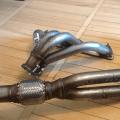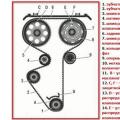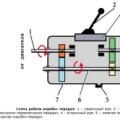In order to replace antifreeze on a Nissan car, first of all, you need to decide on the brand of fluid. According to the manufacturer's recommendations, we will fill the cooling system with antifreeze in the original Castrol Antifreeze NF packaging, or with Nissan L250 Coolant Premix liquid mixed in the following proportions: 1 liter KE90299934 to 5 liters KE90299944. As for the volume, we need 6.7 liters of antifreeze for the Nissan Almera car.
Begins the process of replacing the coolant, which includes three stages: draining the fluid, flushing the cooling system and filling with a new composition. Replacing the antfreeze with Renault Logan is carried out in the same sequence.
- Draining waste antifreeze
Remove the lower engine protection. Disconnect the hose from the radiator and remove the cover. On the cylinder block, we find the drain plugs and turn them out. Next, we remove the tank and directly drain the old antifreeze.
Pay attention to the presence of various contaminants in the waste composition, including rust, discoloration. If you notice unfavorable changes, then it would be prudent not to skip the stage of flushing the system.
- Flushing the cooling system
Pour water into the radiator until it starts flowing out through the bypass plug. Tighten the plug as soon as this happens. Start the engine and allow it to warm up to normal operating temperature. You can slightly press the gas pedal several times. Then we turn off the engine and wait until it cools down, after which we drain the water. This procedure can be repeated if necessary. Also, it will be useful to use chemical cleaners to flush the cooling system, read in detail about their use in the annotation.
- Pouring new antifreeze to Nissan
We put the tank in place, screw the plugs into the drain holes of the radiator and cylinder block. We treat the thread of the last plug with a sealant. Unscrew the bypass plug. Pour antifreeze into the tank, this should be done slowly so that air can escape from the system. The tank is filled up to the maximum level. Retighten as soon as fluid begins to flow out of the bypass plug.
We warm up the engine to operating temperature by first screwing the cap onto the radiator filler neck. Then we muffle and let it cool, you can use the fan to save time. Check the level of antifreeze and, if necessary, top up to the MAX mark.
Next, it is worth checking the tightness of the cooling system with the engine running. Also evaluate the noises that can be heard from the heater, in this case there is excess air in the system that needs to be released. As a final step, wipe off the remains of antifreeze from the engine with a clean cloth.
Remember that it is unacceptable to mix compounds of different colors, this causes unwanted chemical reactions in the car's cooling system. In addition, if you are using a new Nissan antifreeze, flushing the system will be a must.
The optimum temperature for an internal combustion engine is between 80-90 degrees Celsius. To maintain this mode, it is necessary to constantly remove heat from heated parts. All modern cars are equipped with a liquid cooling system, which includes:
- main radiator,
- radiator for oil cooling,
- forced cooling fan,
- pump for pumping liquid,
- thermostat,
- expansion tank,
- connecting pipes,
- temperature sensor.

Also in the cylinder block and its head there are special holes through which the coolant circulates.
There are two circles of antifreeze circulation: small and large. The first is designed to quickly heat the engine and coolant. The second is necessary to cool the antifreeze after it has gone through a full heat exchange cycle.
What is coolant (antifreeze) for
In the past, many car owners used regular water instead of antifreeze. Such actions were erroneous, since the water has a low boiling point, as a result of which scale forms on the inner walls of the cooling system elements. This leads to a deterioration in heat transfer and, as a result, rapid wear of engine parts. To avoid such a development of events, it is necessary to use a special coolant.
Nissan antifreeze replacement timing
Many car owners neglect the timely procedure for replacing antifreeze, but in vain, because from this, as you have seen earlier, the performance of the car engine depends. The first replacement of antifreeze in Nissan vehicles should be carried out after 90 thousand mileage, and each subsequent replacement - every 60 thousand. If you postpone this procedure for the future, you may be faced with the fact that the coolant will begin to change its properties and negatively affect the metal (usually aluminum), from which the cylinder head and the block itself are made.
P - checking the cooling system
З - replacement of coolant
| Automobile model | Mileage thousand km. | 15 | 30 | 45 | 60 | 75 | 90 | 105 | 120 | 135 | 150 | 165 | 180 | 195 | 210 |
| Month | 12 | 24 | 36 | 48 | 60 | 72 | 84 | 96 | 108 | 120 | 132 | 144 | 156 | 168 | |
| Almera N16 (manual transmission, automatic transmission) | P | P | P | P | P | Z | P | P | P | Z | P | P | P | Z | |
| Almera classic B10 (manual transmission, automatic transmission) | P | P | P | P | P | Z | P | P | P | Z | P | P | P | Z | |
| Micra K12 (manual transmission, automatic transmission) | P | P | P | P | P | Z | P | P | P | Z | P | P | P | Z | |
| Note E11 HR (manual transmission, automatic transmission) | P | P | P | P | P | Z | P | P | P | Z | P | P | P | Z | |
| Primera P12 QG (manual transmission, automatic transmission) | P | P | P | P | P | Z | P | P | P | Z | P | P | P | Z | |
| Tiida C11 HR12 (manual transmission, automatic transmission) | P | P | P | P | P | Z | P | P | P | Z | P | P | P | Z | |
| Maxima A33 (manual transmission, automatic transmission) | P | P | P | P | P | Z | P | P | P | Z | P | P | P | Z | |
| Juke F15 (manual transmission, automatic transmission) | P | P | P | P | P | Z | P | P | P | Z | P | P | P | Z | |
| Teana J31 (automatic transmission) | P | P | P | P | P | Z | P | P | P | Z | P | P | P | Z | |
| Quashqai Q10 (manual transmission, automatic transmission) | P | P | P | P | P | Z | P | P | P | Z | P | P | P | Z | |
| Murano Z50 / Z51 (automatic transmission) | P | P | P | P | P | Z | P | P | P | Z | P | P | P | Z | |
| Navara D40 (manual transmission, automatic transmission) | P | P | P | P | P | Z | P | P | P | Z | P | P | P | Z | |
| Pathfinder R51 (manual transmission, automatic transmission) | P | P | P | P | P | Z | P | P | P | Z | P | P | P | Z | |
| Patrol Y61 (manual transmission, automatic transmission) | P | P | P | P | P | Z | P | P | P | Z | P | P | P | Z | |
| X-Trail T30 / T31 (manual transmission, automatic transmission) | P | P | P | P | P | Z | P | P | P | Z | P | P | P | Z | |
| Terrano R20 / F15 (manual transmission, automatic transmission) | P | P | P | P | P | Z | P | P | P | Z | P | P | P | Z |
Instructions for replacing antifreeze in Nissan vehicles

For this car brand, it is recommended to use original Nissan antifreeze (based on ethylene glycol), which is specified in the documentation for the vehicle. If it is not possible to use the original coolant, select an analogue based on the specifications of the fluid.
Do not under any circumstances start replacing with a hot engine, otherwise you can get serious burns.
Also, use gloves.
The coolant replacement process is as follows:
- Unscrewing the tap on the radiator, which is accompanied by the leakage of antifreeze.
- Removing the radiator cap. After that, you will find how the liquid begins to pour out more intensively.
- Removing the expansion tank cover.
- Unscrewing the plug on the cylinder block.
- Tightening the plug on the cylinder block.
- Tightening the tap on the radiator.
- Filling the cooling system with antifreeze.
- Fill the expansion tank with antifreeze to the appropriate mark.
- Tightening the radiator cap and expansion tank.
- Engine starting. During its operation, we observe the readings of the temperature sensor in the cooling system.
- We turn off the engine and look at the liquid level indicator. The level should be between the MIN and MAX marks.
- In order to empty the expansion tank, you need to remove it. This is done easily: we take a suitable wrench and unscrew the bolt that holds the tank. After removing the liquid, disconnect the hose and thoroughly rinse the tank and then dry it.
- As a rule, after draining the antifreeze, some liquid remains in the system. Blow into the filler hole to expel all the coolant.
- After replacing antifreeze, it is recommended to drive a couple of tens of kilometers by car, and then add the required amount of fluid.
- Before pouring new antifreeze, you can flush the system with plain water, or use special compounds.
- Under normal conditions, the boiling point of antifreeze is 108 degrees Celsius, in a sealed cooling system 130 degrees Celsius. Therefore, in the event of a leakage (for example, a crack has formed in the expansion tank or hose), the engine will boil. To avoid this, change the expansion tank with a hose in a timely manner.
If you doubt that you will carry out the antifreeze replacement procedure yourself, then contact a specialized Nissan car service, where experienced and professional mechanics will solve this problem for you.
Complexity
Tool1 - 3 h
Tools:
- Spanner straight 14 mm
- Capacity with a capacity of at least 7 liters
- Rags
Parts and consumables:
- Coolant
According to the manufacturer's recommendation, the coolant should be replaced for the first time after 100 thousand km or 5 years of operation (whichever comes first), and then every 60 thousand km (every 3 years).
Warning:
Use coolants based on ethylene glycol (antifreeze). Change the coolant only when the engine is cold. Coolant is toxic, so be careful when handling it.
When starting the engine, the radiator and expansion tank plugs must be closed. Tighten the radiator cap tightly. The cooling system is under pressure when the engine is running, therefore, with a loosely tightened plug, coolant can leak from under it.
1. Park the vehicle on a level, level surface.
2. Turn the radiator cap counterclockwise.

3. Remove the radiator cap.

4. Remove the left engine mudguard.
5. Place a container under the hose of the drain valve of the radiator of the cooling system, located on the left side of the lower tank of the radiator, unscrew the drain plug by 2-3 turns and drain the liquid from the radiator.

6. Tighten the drain plug.

7. Place a container next to the engine coolant drain hole located on the left side of the cylinder block in the area of \u200b\u200bthe 4th cylinder, unscrew the plug and drain the engine coolant.
8. Replace the engine drain plug.
Warning:
Antifreeze is deadly poisonous to all living things. To avoid polluting the environment, drain it from the radiator and engine through a funnel (for example, made from a plastic soda bottle).
9. Unscrew the expansion tank cap and remove the remaining coolant from the tank, for example with a rubber bulb.

Note:
If the expansion tank is very dirty, then remove and rinse it. Detailed instrumentation is provided.
10. Flush the cooling system by filling the system with water through the filler neck of the radiator to the level of the steam pipe.
11. Start the engine and let it run until the electric fan turns on.
12. Stop the engine and drain the water.
13. Flush the cooling system until clear water flows out.
14. Refill the engine cooling system by slowly pouring coolant into the radiator up to the level of the vapor pipe.
15. Start the engine and warm it up to operating temperature (before turning on the fans). Add coolant to the radiator as air escapes from the system.
16. Screw in the radiator cap and add coolant to the expansion tank up to the "MAX" mark. Then stop the engine and let it cool down.
17. Check the coolant level and, if necessary, top up the expansion tank up to the "MAX" mark.
Note:
When the engine is running, observe the coolant temperature on the gauge. If the arrow reaches the red zone, and the radiator fan does not turn on, turn on the heater and check what air passes through it. If the heater supplies heated air, most likely the fan is faulty, and if it supplies cold air, then an air lock has formed in the engine cooling system. To remove it, stop the engine, let it cool down and unscrew the expansion tank cap. Start up the engine, let it run for 3-5 minutes and screw on the reservoir cap.
To better fill the system without air pockets, periodically squeeze the radiator hoses with your hand. After a few days of car operation after changing the coolant, check its level. Replenish the level if necessary.
If after a very short time the color of the fresh liquid turns brown, it means that you have poured a fake, into which the manufacturer “forgot” to add corrosion inhibitors. In addition, one of the signs of a fake is a sharp complete discoloration of the liquid. The dye of high-quality coolant is very stable and only darkens over time. Liquid tinted with linen blue becomes discolored. This "antifreeze" must be replaced quickly.
The article is missing:
- High-quality photos of repair
Refueling tanks.
Engine coolant filling capacity (with reservoir): ~ 6.7 l.
Tank: 0.7 l.
Antifreeze: in the original packaging from NISSAN comes Castrol Antifreeze NF.
Ready coolant Nissan L250 Coolant Premix:
- 1 Liter KE90299934
- 5 Liters KE90299944
Checking the coolant level.
Make sure the coolant level in the reservoir is between the MIN and MAX marks when the engine is cold.
If there is less or more coolant, bring the level to normal!
Draining the coolant.
1. Remove the lower engine guard.
2. Disconnect the lower hose from the radiator and remove the radiator cap.

3. Remove the drain plugs from the cylinder block.


4. Remove the reservoir and drain the coolant.
Check the coolant for contaminants such as rust, corrosion and discoloration. If there are traces of contamination, flush the engine cooling system.
Flushing the cooling system.
1. Fill the radiator with water until it flows out of the bypass plug, then tighten the plug.
3. Start the engine and warm it up to normal operating temperature.
4. Depress the accelerator pedal two to three times without load.
5. Stop the engine and wait until it cools down.
6. Drain the water.
Filling the engine with coolant.
1. Install the reservoir, screw the plugs into the drain holes on the radiator and cylinder block.
2. Apply sealant to the threads on the drain plug on the cylinder block.
3. Use a proprietary sealant or equivalent.
4. Unscrew the bypass plug.
5. Fill the radiator and reservoir to the required level. Add coolant slowly at a rate of less than 2 liters. per minute so as to allow air to escape from the system.
6. Tighten the bypass plug when coolant starts to flow out.
7. Start the engine and warm it up to normal operating temperature by removing the cap from the radiator. If coolant spills out of the radiator filler neck, replace the cap.
Let the engine run at 3000 rpm for 10 seconds, then return to rpm by tightening the cap on the radiator.
8. Repeat two to three times.
ATTENTION! Observe the coolant temperature gauge so as not to overheat the engine.
9. Stop the engine and cool to below 50 ° C. To save time, cool with a fan.
If necessary, top up the radiator with coolant up to the filler neck.
11. Check the cooling system for leaks with the engine running.
12. Warm up the engine and check for the sound of flowing coolant by increasing the engine speed from idle to 3000 rpm and setting the heater temperature control to several positions between COOL and WARM.





